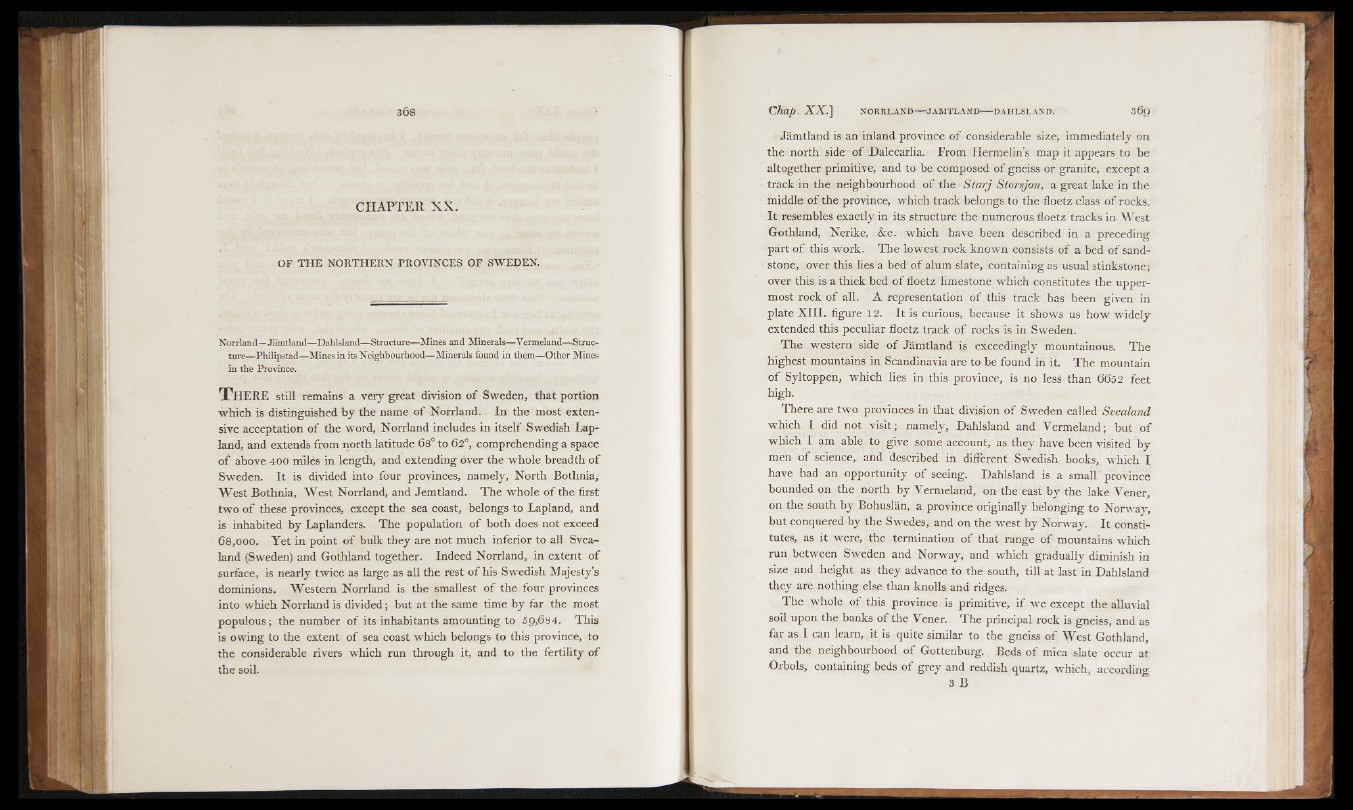
C H A P T E R X X .
OF T H E NORTHERN PROVINCES OF SWEDEN.
Norrland—Jamtland—Dahlsland—Structure—Mines and Minerals—Vermeland—Structure—
Philipstad—Mines in its Neighbourhood—Minerals found in them—Other Mines
in the Province.
T h e r e still remains a very great division o f Sweden, that portion
which is distinguished by the name o f Norrland. In the most extensive
acceptation of the word, Norrland includes in itself Swedish Lapland,
and extends from north latitude 68° to 62°, comprehending a space
of above 400 miles in length, and extending over the whole breadth of
Sweden. It is divided into four provinces, namely, North Bothnia,
West Bothnia, West Norrland, and Jemtland. The whole of the first
two o f these provinces, except the sea coast, belongs to Lapland, and
is inhabited by Laplanders. The population o f both does not exceed
68,000. Yet in point of bulk they are not much inferior to all Svea-
land (Sweden) and Gothland together. Indeed Norrland, in extent of
surface, is nearly twice as large as all the rest o f his Swedish Majesty’s
dominions. Western Norrland is the smallest of the four provinces
into which Norrland is divided; but at the same time by far the most
populous; the number o f its inhabitants amounting to 5Q,684. This
is owing to the extent of sea coast which belongs to this province, to
the considerable rivers which run through it, and to the fertility of
the soil.
Jamtland is an inland province of considerable size, immediately on
the north side o f Dalecarlia. From Hermelin’s map it appears to be
altogether primitive, and to be composed of gneiss or granite, except a
track in the neighbourhood of the Starj Storsjon, a great lake in the
middle of the province, which track belongs to the floetz class o f rocks.
It resembles exactly in its structure the numerous floetz tracks in West
Gothland, Nerike, &c. which have been described in a preceding
part of this work. The lowest rock known consists of a bed of sandstone,
over this lies a bed of alum slate, containing as usual stinkstone;
over this is a thick bed o f floetz limestone which constitutes the uppermost
rock of all. A representation of this track has been given in
plate XIII. figure 12. It is curious, because it shows us how widely
extended this peculiar floetz track of rocks is in Sweden.
The western side of Jamtland is exceedingly mountainous. The
highest mountains in Scandinavia áre to be found in it. The mountain
o f Syltoppen, which lies in this province, is no less than 6652 feet
high.
There are two provinces in that division o f Sweden called Svealand
which I did not visit; namely, Dahlsland and Vermeland; but of
which I am able to give some account, as they have been visited by
men of science, and described in different Swedish books, which I
have had an opportunity o f seeing. Dahlsland is a small province
bounded on the north by Vermeland, on the east by the lake Vener,
on the south by Bohuslan, a province originally belonging to Norway,
but conquered by the Swedes, and on the west by Norway. It constitutes,
as it were, the termination of that range of mountains which
run between Sweden and Norway, and which gradually diminish in
size and height as they advance to the south, till at last in Dahlsland
they are nothing else than knolls and ridges.
The whole of this province is primitive, i f we except the alluvial
soil upon the banks of the Vener. The principal rock is gneiss, and as
far as I can learn, it is quite similar to the gneiss of West Gothland,
and the neighbourhood of Gottenburg. Beds of mica slate occur at
Orbols, containing beds o f grey and reddish quartz, which, according
3 B